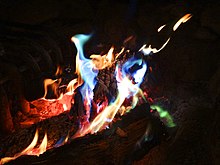This article needs additional citations for verification. (April 2018) |


Colored fire is a common pyrotechnic effect used in stage productions, fireworks and by fire performers the world over. Generally, the color of a flame may be red, orange, blue, yellow, or white, and is dominated by blackbody radiation from soot and steam. When additional chemicals are added to the fuel burning, their atomic emission spectra can affect the frequencies of visible light radiation emitted - in other words, the flame appears in a different color dependent upon the chemical additives. Flame coloring is also a good way to demonstrate how fire changes when subjected to heat and how they also change the matter around them.[1][2]
To color their flames, pyrotechnicians will generally use metal salts. Specific combinations of fuels and co-solvents are required in order to dissolve the necessary chemicals. Color enhancers (usually chlorine donors) are frequently added too, the most common of which is polyvinyl chloride. A practical use of colored fire is the flame test, where metal cations are tested by placing the sample in a flame and analyzing the color produced.[3][4]
- ^ "Blackbody Radiation". Archived from the original on 2014-01-08.
- ^ "Atomic Absorption and Emission Spectra". Archived from the original on 2014-03-26. Retrieved 2014-04-01.
- ^ "flame tests". Chemguide.co.uk. Retrieved 2017-08-02.
- ^ "Pyrotechnic Chemicals - Chlorine Donors". Skylighter, Inc. Retrieved 2017-08-02.